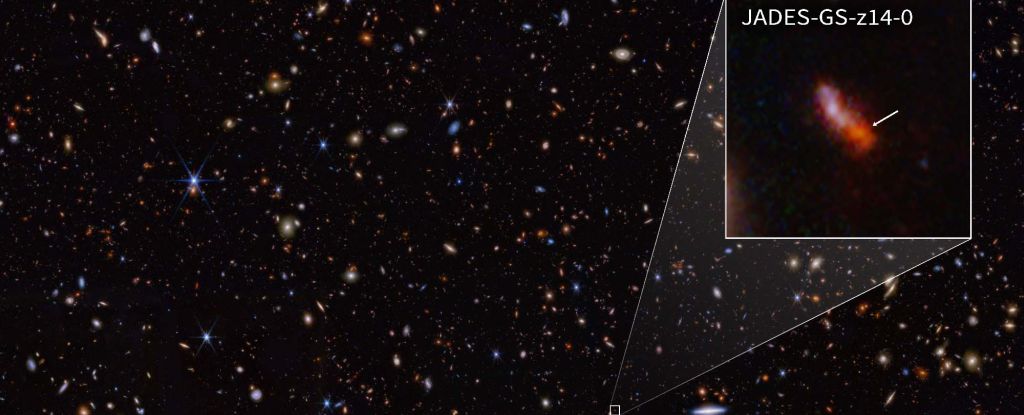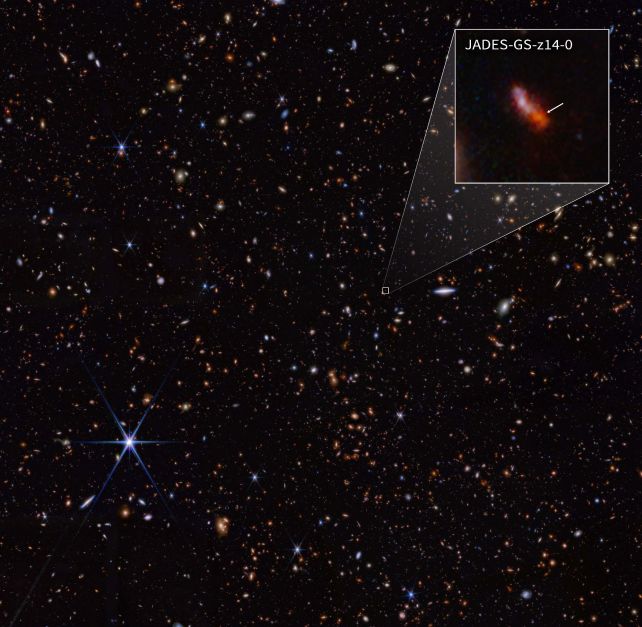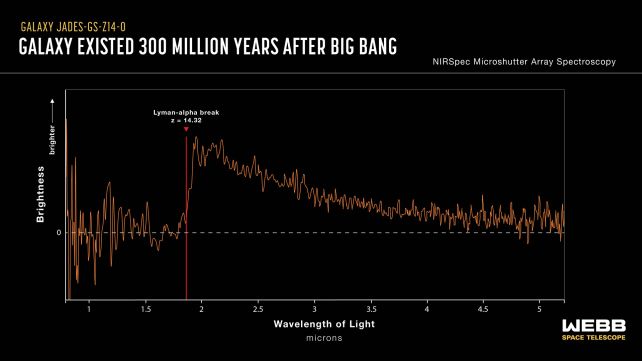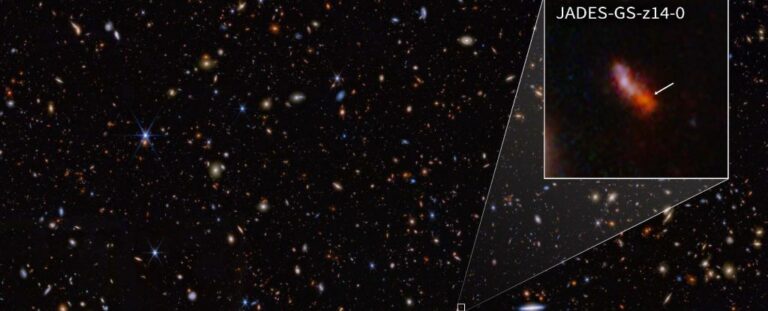Astronomers have recently made a groundbreaking discovery by identifying the most ancient galaxy ever observed.
This newly discovered galaxy is the earliest of its kind observed so far, and it challenges existing theories on galaxy formation.
This galaxy, named JADES-GS-z14-0, is actively forming stars in the early Universe and has been observed only 278 million years after the Big Bang. Another recent discovery, JADES-GS-z14-1, has also been found to be almost as distant.

These detections have been described by astronomers as “unambiguous,” which could mean that the Cosmic Dawn, a highly significant epoch in the formation of the Universe, may still need more light shed on it.
Said astronomers Stefano Carniani of Scuola Normale Superiore in Italy and Kevin Hainline of the University of Arizona, NIRSpec looked at JADES-GS-z14-0 for about ten hours in January 2024. After analyzing the spectrum, they observed clear signs that the redshift of the galaxy was 14. 32, breaking the record of the previous most distant galaxy.
From the images, it was discovered that the source covers more than 1,600 light-years, which means that most of the observed light comes from youth, and not emissions near the growing supermassive black hole. It indicates that the total mass of the galaxy is several hundred million times the mass of the Sun. This brings about an interesting question as to how nature can fashion such a bright, large and massive galaxy just within 300 million years.
These findings have been reported in three papers uploaded in the preprint server arXiv. While they have yet to undergo peer review, all three papers reach the same conclusion: JADES-GS-z14-0 clearly does exist and provides the fundamentally important source of data on the evolution of the Universe at its early stage.

For a long time, humankind did not have a profound idea about the period that happened in the universe after the Big Bang; it was known as the Cosmic Dawn. In the planetary system of about 8 billion years ago it was much more restrained. The universe was filled with fog of neutral hydrogen which inhibited the process of light from moving far away.
Nevertheless, this fog became transparent in the course of time after being ionized by the ultraviolet radiation from varying celestial formations existing in the early Universe. At the end of the Cosmic Dawn, space was made to be permeable.
Many stars and galaxies had already begun to appear during this time period as well. For purposes of understanding the roots of the phenomenon, there was a need to look behind the hitherto obscuring haze.
This is where the James Webb Space Telescope (JWST) comes into play, equipped with infrared advantages that are unmatched by any other space telescope. It is worth mentioning that infrared radiation is the only form of light that can penetrate dense areas often opaque to other forms of light due to their long wavelengths, which do not scatter easily. With the help of the JWST Advanced Deep Extragalactic Survey (JADES), unexpected results have been obtained, concerning objects that existed in the early stage of the universe, more exactly 650 million years after the Big Bang.
One interesting revelation that has been made is that there were much larger structures far ahead of the earliest anticipated date. It has been intriguing to know that this discovery negates the belief that forming supermassive black holes and galaxies can take a large amount of time, more than that of our years of observation.
Nevertheless, the most interesting discovery is JADES-GS-z14-0. This object was especially notable for its great size and extreme brightness and would not have been expected by astronomers to have observed galaxies when the Universe was still young. What is more, its size makes it look as if the light is produced mainly by stars rather than the dazzling glow which is observed near a growing supermassive black hole.

The dust and oxygen identified within the light analysis are fairly high even at this phase of development. Usually such hefty elements, are born in stars and need explosions, more properly termed as supernovae. This implies that there should have been generations of several large stars which died within the time of 300 million years of big bang.
While contemporary supermassive stars can live for merely a few million years at the most, this scenario is by no means implausible. It does not fully meet the expectations of astronomers but still it is not so disappointing either.
In light of these features of this galaxy, we have to re-interpret the context under which the early universe developed. This shows that the large number of light sources observable cannot be accounted for by the development of black holes alone. For some reason, bright and large, well-formed galaxies are capable of formation during the Cosmic Dawn.
However, Carniani has stated that the phenomenon in question is now represented by the galaxy known as JADES-GS-z14-0. One would find it rather astonishing that the Universe was able to create such a massive galaxy in only 300 million years.
The discovery paper led by Carniani can be found on arXiv. Simultaneous papers studying the properties of the galaxy’s light can be found on arXiv here and here.
Do not forget to share your opinion with us to provide you with the best posts !




0 Comments